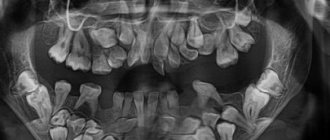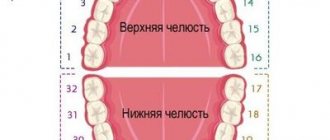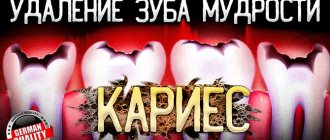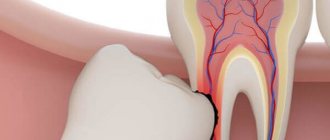Eighth tooth, figure eight, third molar: how many wisdom teeth does a person have?
In the modern world, wisdom teeth are considered something of a rudiment, that is, an organ that has lost its significance in the process of evolutionary development. That is why their appearance is greatly delayed or may not take place at all. As a rule, an adult has a maximum of 32 teeth, including 4 wisdom teeth.
However, a person can have more than 4 wisdom teeth - such cases occur quite often in dental practice! Two or more wisdom teeth may erupt, or none may appear: it all depends on the individual characteristics of the body and the structure of the dentofacial apparatus. Although a set of 32 molars is considered ideal, a number of 28 to 32 is also considered normal.
Differences between upper and lower wisdom teeth
Compared to the upper ones, the lower “eights”, as a rule, have a larger number of root canals. In addition, their removal is more difficult because the bone tissue in the lower jaw is considered denser. Otherwise, there are no significant differences.
How long do eights grow?
The process takes place individually. At what age a wisdom tooth can erupt depends on its readiness. By the age of 17, its main part (crown) is just beginning to form. The roots are still in progress. This will continue for about 3-4 years. In the range of up to 40 years, you can expect its appearance from the gums. For each person, this process occurs differently in terms of time and symptoms. The Guinness Book of Records records the latest case at 94 years. Some people experience a whole list of unpleasant symptoms with pain and fever, while for others everything happens quietly and calmly. At what age wisdom teeth erupt is a secondary matter. The speed of appearance is influenced by the size of the jaw. If there is not enough space, it will be difficult for the crown to come out of the gums.
Why is wisdom tooth called this?
Wisdom teeth usually begin to erupt after adulthood. Compared to other molars, which appear in childhood, we acquire wisdom teeth already as mature people, so they got their name precisely based on age. Another popular designation for wisdom teeth is third molars or “figure eights.” Here, too, everything is obvious: if you draw the midline of the face, you can see that the wisdom tooth is the eighth tooth on the left or right side.
What to do if your gums are inflamed
Contact your dental surgeon immediately. Before you plan to do this, you can take an anesthetic (ketorol, analgin, etc.) orally. It is advisable to rinse the oral cavity with a cold solution, which is prepared at the rate of 1 teaspoon of soda and the same amount of salt per glass of water.
Treatment of such a pathology consists of incision (opening) of the mucous “hood”, further washing of the cavity and taking anti-inflammatory and analgesic drugs. If a large amount of pus is removed during the autopsy, the patient must also take antibiotics. If the gums surrounding the wisdom tooth become inflamed again, then most often the dentist advises removing the wisdom tooth.
Caries
Carious lesions are another common problem that occurs during the eruption of wisdom teeth. The development of this pathology is due to the fact that the eighth teeth are located in a hard-to-reach place, which prevents good daily oral hygiene. Often, a wisdom tooth may erupt with initial signs of caries and damaged enamel. Due to the fact that such teeth are always pressed tightly against neighboring teeth, caries can quickly spread to them. In this case, after an examination, the dentist will decide whether the wisdom tooth can be treated or whether it is better to remove it.
Time of appearance of wisdom teeth
The wisdom tooth “climbs in” much later than the other teeth. “Eights” do not have rudiments in the form of milk teeth: they appear at 3–5 years, and the crown part begins to form at about 12 years, when the replacement of temporary teeth with permanent ones ends. Children's wisdom teeth usually do not emerge until they are 16 years old. The average age of their appearance is 21–25 years, but there are cases of late eruption after 30 years. Sometimes eights may not grow at all.
Many people are also interested in how long the wisdom tooth is cut (how long the wisdom tooth grows until the crown part appears above the gum). On average, this process takes from several days to a month, but the roots of the “eight” are formed several years after its eruption.
Help with home remedies -
As we said above, only with minor discomfort and inflammation can you cope with the situation with home remedies. It is better to use analgesics from the NSAID group (non-steroidal anti-inflammatory drugs) as an anesthetic. These drugs (for example, based on ibuprofen) have not only analgesic, but also a pronounced anti-inflammatory effect. If there are symptoms of inflammation of the hood above the wisdom tooth, it is necessary to use antiseptic rinses and anti-inflammatory gel applications.
- Chlorhexidine solution 0.5% - rinse 2-3 times a day for 1 minute, the solution is sold at the pharmacy ready to use. Immediately after rinsing, blot the gum above the wisdom tooth with a dry gauze swab and apply anti-inflammatory gel (it adheres better to dry mucous membranes).
- Applications of Cholisal gel are carried out 2-3 times a day, immediately after antiseptic rinsing. The gel is applied with light massaging movements to the hood area, then apply another portion of the gel to the hood without rubbing it. After application, it is not advisable to eat or rinse your mouth for 2-3 hours (you can drink). By the way, this gel not only relieves inflammation, but also has an analgesic effect.
However, keep in mind that if you have swelling of the cheek, difficulty opening your mouth, painful swallowing, suppuration from under the hood, swelling and pain in the submandibular area, you cannot self-medicate and should urgently consult a doctor. We hope that our article on the topic: How wisdom teeth are cut was useful to you!
Sources:
1. Higher prof. the author's education in surgical dentistry, 2. Based on personal experience as a dental surgeon, 3. National Library of Medicine (USA), 4. “Pathology of wisdom teeth eruption” (Rudenko A.), 5. “Qualified removal of third molars” ( Asanami S.).
Symptoms of wisdom teeth erupting
Many people ask what to do if a wisdom tooth grows? The answer is obvious: contact a dentist who will monitor the entire process and be able to take the necessary measures in a timely manner if complications arise. The signs of a wisdom tooth (its eruption) are different for everyone, and some of us do not notice their appearance at all. But not everyone is so lucky: if a wisdom tooth begins to grow, then in many cases this is still accompanied by some discomfort.
How to understand that a wisdom tooth is growing?
- Inflammation and swelling of the gums appear in the eruption area.
- There is pain in the jaw area.
- The temperature rises.
- A characteristic hood forms over the coronal part of the wisdom tooth. If the tooth remains impacted (not fully erupted), the hood often becomes the cause of pericoronitis.
You can get a quality consultation on wisdom teeth in your city
I want to check my eights!
Treat or remove eights?
Now regarding orthodontic treatment and wisdom teeth. Believe me, it is very unpleasant for us doctors, as well as for patients, to make radical decisions. But there are good reasons! These are your own stories. Stories of patients who underwent treatment with braces as teenagers, achieved excellent results and...
All the beauty of straight teeth, especially the lower incisors (you just started to enjoy a beautiful smile) - it disappears at 20 and beyond. It is when most of us fully develop these “eights”. Two, three and even four years of therapeutic “torment” to correct crooked teeth, transform them into a beautiful/sweet/courageous smile, as they say, down the drain... Yes, yes - the only option to become the owner of beautiful teeth again is repeated orthodontic treatment. It doesn’t matter whether it’s aligners or braces again, the important thing is that there is a good saying: forewarned is forearmed! No one is immune from mistakes and relapse.
Our body is beautiful and magical in that it almost always adapts and compensates for almost any pathology. Therefore, the “eights” cut through with difficulty and subsequently deform
there are very important teeth in front!
Wisdom tooth root
Despite the fact that visually wisdom teeth are practically no different from ordinary molars, there are still some differences. We are talking, first of all, about root canals: in figure eights they are much more curved, so it is very difficult to carry out endodontic treatment, taking into account also where the wisdom tooth is located (in the most inaccessible area of the dentition). The number of roots of wisdom teeth also varies: there may be four or five, or maybe even one (when several canals grow together).
Delete or leave unchanged
This is a topic of active debate among dentists and researchers. Regardless of how old people are when wisdom teeth appear, doctors recommend removing them. There are a number of contraindications for removal:
- missing 1 or 2 molars (6 and 7 in a row);
- the tooth position is vertical;
- history of viral infections in the active stage;
- There is a possibility of treatment for caries.
Age 17, 20 or 35 – it is not so important at what age a wisdom tooth comes out in the jaw. If you feel good, there are no acute inflammatory processes in the gums, and there is no crowding of other teeth, removal can be postponed. This is normal dental practice. If there is aching pain, intoxication with high fever, signs of gumboil, removal is indicated in 99% of cases. Knowing the information at what age wisdom teeth come out in men and women, you can mentally prepare for this process. Everything else and the peculiarities of the development of events depend on genetics and nature. Monitor your condition, undergo preventive examinations on time and, if urgently necessary, seek dental care.
Wisdom tooth growth: what should you be wary of?
A correctly positioned wisdom tooth (correct wisdom teeth) rarely causes discomfort to its owner, but a complex wisdom tooth can lead to very unpleasant complications. This is usually the name given to the third molar, which has an incorrect position of the rudiments or provokes complications when erupting. You need to understand that, being a rudiment, the figure eight literally wedges itself into the dentition: in some cases this happens quite organically, but in others it does not. In most situations, the culprit is incorrectly formed rudiments of wisdom teeth, located too deep, horizontally, or almost resting on neighboring teeth.
Let's see how wisdom teeth led to crowded teeth
And how crowded teeth are eliminated with Star Smile aligners
The video shows how the 3D setup is done. I am commenting on the video, orthodontist Alexander Spesivtsev, clinical director of Star Smile, a doctor with many years of experience in the successful use of aligners in orthodontic practice. To restore straight dentition, the wisdom teeth themselves—the eights—had to be removed. At Star Smile, or rather in the clinics of its partners (more than 70 cities in Russia), any treatment begins with diagnosis and drawing up a virtual setup. The doctor takes photographs of the patient’s face, dentition, as well as x-rays and dental casts. Using special software, the obtained data is processed and a three-dimensional model of the patient’s dental system is obtained. And this already allows you to calculate the trajectory of tooth movement, treatment time, and the required number of sets of aligners. Also, the final result of the treatment will be visualized - the patient will be able to evaluate the aesthetics of the smile after treatment. Patients really like this approach - they can see their future smile, their straight teeth. The forecast of a 3D setup when straightening teeth with aligners comes true in almost 100% of cases. You see, this is completely different from correcting a “blind” bite, as is usually the case with braces. Everything is clear here, without any guesswork or assumptions.
Gevorkyan Oscar Vladimirovich
Candidate of Medical Sciences, Oral and Maxillofacial Surgeon, Central Scientific Research Institute, Scientific Consultant Star Smile “ If you are faced with questions
:
- To remove or not to remove wisdom teeth?
- How dangerous is it to remove wisdom teeth?
- When do wisdom teeth interfere with orthodontic treatment?
- and most importantly, is it possible to avoid the removal of “eights”?
Feel free to contact the doctors at Star Smile, they will help you understand this sometimes complex, but very important life problem for many.
Do not delay the decision in order to avoid possible complications in the future.” Since the Star Smile company is represented in all federal districts, large and medium-sized cities of Russia and interacts with many clinics and orthodontists, we offer you the opportunity to undergo a free consultation with high-quality orthodontists in your city , where you can discuss the problem of wisdom teeth and determine the optimal solution for you. To do this, you need to fill out the form below, a Star Smile medical specialist will contact you and help you by scheduling a consultation at a convenient time or providing your doctor’s contact information.
Don’t put off the problem of wisdom teeth “for later”!
Complications resulting from the growth of “wise teeth”
- Malocclusion and crowded dentition.
In this case, the eighth tooth simply does not have room for normal eruption and placement. - Pressure and damage to the adjacent tooth.
If there is not enough room for the eight to grow, it begins to push against its neighbors. - Pericoronitis.
When the eruption of the figure eight is difficult, the soft tissues in this area become inflamed due to the activity of pathogenic bacteria. A so-called gum hood forms over the tooth, in which food debris accumulates, which provokes infection. The main syndrome is severe aching pain, inflammation, and sometimes purulent discharge. - Inflammation of the trigeminal nerve.
Incorrect position of the wisdom tooth can affect the trigeminal nerve, which manifests itself in the form of pain and uncontrollable twitching of the facial muscles. - Osteomyelitis and dental cyst.
The main causes of pain
Painful symptoms from wisdom teeth are caused by the anatomical features of the upper and lower jaw, which are already fully formed in a person at the age of 17-25.
As the figure eight begins to grow, it puts pressure on neighboring teeth, bone and soft tissue. The growth process can last for months and even years, so pain manifestations are temporary, periodically fading and exacerbating.
The pain of tooth 8 can be provoked not only by its growth or anatomically incorrect position, but also by the presence of various pathologies, for example, caries, pulpitis, periodontitis or a wide range of infectious diseases. Note! The lack of timely professional help can provoke a worsening of the situation, which will result in the need to remove the diseased tooth and treat complications.
Why do people need wisdom teeth?
Are wisdom teeth necessary? This is perhaps one of the most common questions asked by millions of patients who come to the dentist’s office. Ancient people who lived tens of thousands of years ago had a larger and more massive jaw, so they could accommodate more teeth. This helped chew hard and tough foods. Over time, the need for this disappeared, so wisdom teeth gradually became a vestigial organ. Of course, only nature knows the exact answer to the question of why wisdom teeth grow in modern people, but one should not think that they are absolutely useless. Despite the fact that third molars are almost not involved in distributing the chewing load, wisdom teeth in adults can become a support for a prosthesis, and also prevent bone loss in the absence of neighboring molars.
What you should not do if your wisdom tooth is sick:
- Under no circumstances should you apply any heat to your cheek (including heating pads), or rinse your mouth with warm water. As a result of any warming, the infection can spread even more, even suppuration of the bone tissue is possible.
- It is not recommended to put painkillers on the tooth area, because as a result, not only will the pain not be relieved, but an ulcer may form on the gum.
- Under no circumstances should you use advice given by friends and relatives. This or that remedy can help them, but the exact cause and diagnosis are unknown, as a result of which your wisdom tooth is swollen.
Treatment of pathologies with the growth of eights
When a wisdom tooth grows, you should definitely consult a doctor, especially if there is pain or acute inflammation of the mucous membrane over its chewing surface. Consultation with a specialist is also required if pain of unknown etiology occurs - pressing, spreading throughout the lower jaw, appearing when chewing and opening the mouth. In such a situation, you need to take a panoramic photo to establish the exact cause of this condition - it is quite possible that the tooth is located inside the jawbone and is not externally noticeable.
If growth is accompanied by swelling and redness of the mucous membrane, gums moving away from the crown, and acute pain, maintenance therapy is necessary. It is extremely important for the patient himself to carry out the maximum possible oral hygiene - brush the growing wisdom tooth in the morning and evening, use an irrigator after each meal. It is this product that will most effectively remove food debris and bacteria, stopping inflammation.
In case of a serious inflammatory process, plastic surgery may be required to excise the hood - under local anesthesia, part of the gum is cut off, and the space is cleared of deposits. At the same time, drug therapy is prescribed, which will stop the inflammatory process and restore the condition of the tissues.
At the Smile-at-Once clinic, the issue of removing the 8th tooth is resolved strictly individually. We make sure to take a panoramic photo, which allows us to assess the position and degree of impact on the entire dentition. If there is an opportunity to save a tooth and treat it, the clinic’s doctors will definitely take advantage of it.
Post-operative care
After wisdom tooth removal, many patients experience severe pain for several days. Painful sensations affect not only the jaw, but also spread to the head, throat, and ear. You can take painkillers for three days, but if the pain does not go away, you should seek help from a specialist.
To alleviate the condition after surgery, you must follow these recommendations:
- When a wisdom tooth is removed, it is forbidden to touch the site of its removal with your tongue or fingers for 4 hours after the operation.
- After removing the “eight”, you need to apply a cold compress to your cheek every 20 minutes throughout the day. Such actions will reduce the intensity of pain and relieve inflammation.
- After the operation, it is forbidden to eat for the next 3 hours, and during the day, avoid drinking alcohol and stop smoking.
- Avoid excessive activity of facial expressions for several days.
In rare cases, a wisdom tooth after removal can cause the development of sore throat and inflammation of the tonsils. For such complications, special therapy is required.
This article is for informational purposes only, please consult your doctor for details!
Other publications:
- How to brush your teeth correctly?
- The period of changing teeth in a baby: diagram, approximate timing of the process of tooth loss in babies, advice from a doctor on caring for the oral cavity.










